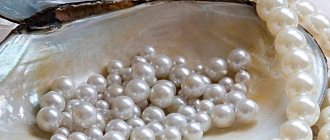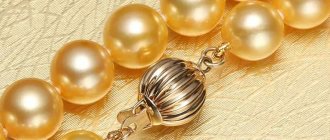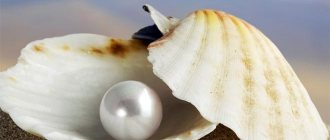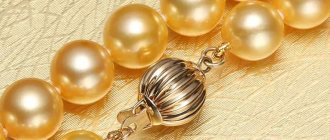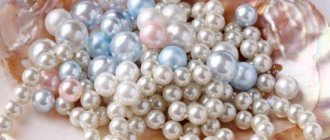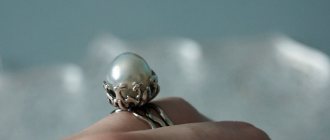Story
People have known what pearls are since ancient times. It has long been found in the shells of marine and freshwater mollusks. This stone is the most ancient jewel on our planet.
It is believed that it was first discovered by accident while catching edible bivalves. Scientists believe that this happened in the waters of the Gulf of Mannar about 4,000 years ago .
The gem began to be used as jewelry and even as a monetary equivalent.
He was highly valued in the East - from China to North Africa, and was adored by the queens of ancient times - Semiramis, Cleopatra and others. The importance of pearls was so great at that time that Cleopatra considered earrings with two large pearls the most valuable of her jewelry.
This stone was highly valued in countries with access to the sea. They decorated statues of gods and heroes and were awarded for military exploits.
On the famous Monomakh's hat, pearls shimmer softly among other gems, and it is crowned with a cross with pearls.
Since the Middle Ages, these stones have been used to decorate crosses, icons, and robes of clergy, since among Christians pearls are a symbol of infallibility and purity.
The Russian word “pearl” comes from the Chinese name for this stone - “zhen zhu”. In Rus' it appeared through the Volga-Bulgar and ancient Turkic languages.
In most European languages, the name of this gem has the Latin root perl. It comes from a now unused word that denoted a specific type of mollusk.
In Russian, nacre is the outer coating of pearls.
Pearls, their structure and life expectancy of pearls
Pearls, as well as corals, shells, jet, ivory, resins, and tortoise shell, are classified as precious stones of organic origin.
.
In nature, substances of organic origin did not appear simultaneously. Their evolutionary process lasted millions of years. From the earliest period, people found and used them for various purposes, this is established by numerous archaeological finds at burial sites.
What are pearls?
Pearl is a complex organomineral aggregate consisting of aragonite and organic matter.
Man turned his attention to pearls already in the most distant times. It is mentioned in ancient Indian and Persian legends, and was found in Egyptian pyramids and Chinese burials.
The sacred Chinese and Indian books say that pearls were highly valued already in ancient times - almost 5 thousand years ago.
The name pearl comes from the Chinese zhen-ju, the Arabs called it zenchug, and in India - manyara. The Slavs, Germans and French called it pearl. One of the first mentions of pearls in Ancient Rus' dates back to the 10th century.
In the 17th century in Russia, the Stroganov merchants secretly decided to grow pearls.
In Solvychegodsk, on their property, a small pond has been preserved, which is called Zhemchuzhny in memory of attempts to grow Russian pearls. At the beginning of the 19th century, in the East of Russia they finally learned to grow pearls and got good results: within five years, pearls reached five millimeters in diameter.
Pearl shape
The shape of pearls can be regular spherical - and round pearls are the most valuable. Pear-shaped and teardrop-shaped pearls are used to produce various jewelry pendants - pendants, earrings. Pearls can be oval, hemispherical (buttons), irregular (baroque) in shape. Large pearls of bizarre shape are called paragon or monster.
Thanks to complex refractions and reflections of light from the wavy surface of the pearl layers, a play of color is achieved. Slightly noticeable, gentle tints of color, a bright spot of light on the surface, a regular spherical, and sometimes the most bizarre shape have brought pearls fame and admiration from all peoples of the world.
The words pearl, pearl, and today are synonymous with the most beautiful, wonderful and perfect.
In ancient times, entire treatises were dedicated to pearls with descriptions of many varieties depending on size, shape and color; they were sung in poetry, poems, and novels. They decorated clothes, household utensils, frames of revered icons and book bindings.
In the XI–XII, and then in the XU–XIII centuries, patterned pearl embroidery on silk, linen, velvet, and brocade became widespread. Pearls were used to embroider church items, ceremonial royal, princely and boyar clothes. Mainly freshwater pearls were used for this.
Queen Mary Stuart of Scotland and Empress Catherine II of Russia both wore beautiful pearl necklaces.
The two gems in XUI were considered the best. They belonged to Catherine de Medici. Later they were presented to Mary Stuart, and after her execution they became the property of Elizabeth of England.
Freshwater pearls
In France, Scotland and the USA, freshwater pearls are mined, the beauty and cost of which is not inferior to sea pearls
.
Freshwater pearls can be of different colors - white, gray, brown, black with pink, golden, bluish and lilac tints. It was used on necklaces, mantles, wrists, and inserted into rings, earrings, and brooches. In the East, large pearls were inserted into the eye sockets of statues of deities.
Pearl size (classification)
By size they distinguish: tiny, small (up to 2.5 mm), medium (2.5–6 mm), large (over 6 mm) pearls. Pearls with a diameter of more than 7–8 mm of high jewelry quality are rare and incredibly highly valued.
It must be said that in history there are known finds of pearls the size of a pigeon egg or more.
Large pearls are very rare and are highly valued. The size of large pearls can be from 10 to 15 millimeters. The London Museum houses a pearl weighing 85 g, its diameter is 45 millimeters.
Pearls are valued for their beauty, rarity, and soft iridescent shine. There are famous specimens in size and beauty, for example, “Queen of Pearls” 112 grains, Khoneh - 1888 grains, Shah-Safi - 513 grains, Regent - 346 grains.
The largest pearl in the world was considered the “Pearl of Allah”, extracted from a pearl oyster weighing more than 300 kg. The weight of the pearl is 6.35 kg.
Pearls and their structure
Pearls attached to the shell are called blisters. It is a deposit of nacreous substance (hard deposits of calcium carbonate) in the shells of marine and freshwater mollusks.
A pearl has a core, prismatic and lamellar layers
.
The composition of the core includes fragments of minerals (quartz, feldspar, etc.), shells, clots of organic matter and other foreign particles that formed the center, and pearl formation occurred around it. These foreign particles get inside the shells, under the mantle of the mollusk and irritate its body. Carrying out a protective reaction, the mollusk envelops the foreign body with its secretions, a dense shell grows around the foreign bodies, which is calcium carbonate, impregnated with a horny substance - nacre (conchiolin). Jewelry-quality pearls have shells represented by lamellar layers.
Pearl color
The color of a pearl is determined by transparency (the depth of the reflective layer), brilliance (the intensity of the reflected color), sparkle (the reflection of light in the form of a luminous spot), the nature of the underlying layer, as well as the composition of microimpurities.
Pearls may have some degree of transparency
, which is considered very valuable.
The strongest shine with a mother-of-pearl tint is observed in pearls from the Manaar and Persian gulfs, i.e. from the East, which is why high-grade pearls are called Orient (East) or Orietal.
Gloss is related to the refraction and interference of light in the lamellar layers.
The color is sometimes white, sometimes with various shades - pink, blue, golden, yellowish, cream, reddish, brownish, etc. White, yellowish, pinkish and bluish pearl colors are considered the best. Black, blue, green - rare.
Pearl mining and processing
Digging for pearls is the backbreaking work of thousands and thousands of divers.
Pearls have been used in jewelry since ancient times in the form of beads, earrings, rings, pins, sewing, etc.
Pearls are not processed, but only drilled.
In order to refine pearls from the late 19th – early 20th centuries, they began to artificially color . Pearls are dyed black, pink and any other color.
Cultured pearls
90% of the modern pearl trade (Japan, to a lesser extent Australia) is cultured pearls.
The method of artificial cultivation of pearls was patented by the Japanese Kokihi Mikimoto. It was preceded by experiments on coating metal Buddha figurines with mother-of-pearl, inserted into the shells of freshwater mollusks in China (13th century), by the experiments of the German scientist F. Alverdes. There are nuclear (a core - various substances and additive tissue - is inserted into the shell of a mollusk) and non-nuclear (pieces of another mollusk are inserted into cuts in the mantle) methods of growing pearls.
Read more in the article about growing pearls.
After an appropriate operation, young mollusks are placed in metal cages with small cells and immersed in the sea, where they live from 3 to 7 years.
Grown pearls reach significant sizes.
Larger pearls are grown near Australia, Burma, the Solomon Islands, and the Philippines. Large pearl oysters weighing up to 8 kg and 30 cm in diameter produce pearls of black, green, bronze, bluish and all shades of gray. Work on growing artificial pearls is currently underway in Polynesia.
The properties and appearance of artificially grown and natural pearls are almost the same.
Lifespan of pearls
The lifespan of pearls is limited and depends on the conditions of storage and use. According to the observations of scientists, researchers, and jewelers, it lives from 150 to 300 years , then it wrinkles, dries out, and loses its attractiveness.
In museum conditions, pearls can be preserved for up to 600 years , and if contact with the atmosphere is completely excluded, they can be preserved for thousands of years .
Archaeologists are finding fossil pearls that are hundreds of millions of years old. Thus, freshwater fossil pearls were discovered in Mongolia, which are almost 100 million years old. An even older one was found in shells in sediments in Central Asia.
Drying contributes to the “aging” of pearls.
when organic matter, which includes water, is destroyed, as well as mechanical damage, dissolution of the surface layer, cracking and other factors.
Constantly wearing pearls and proper storage prolongs their life. Therefore, if you have pearl jewelry, wear it as often as possible!
Jewelry made from it can be worn by many generations. It should be stored in a not very dry and humid place, not in the sun. It is best to keep the pearls in a separate box so that they do not touch jewelry made of stones, which could get scratched.
When dullness appears, the pearls are washed in a weak solution of soapy water and polished with bran.
Imitation pearls
Various imitations of pearls have long been known. They are hollow glass balls coated on the inside with a layer of “pearl essence” made from bleak fish scales, filled with opalescent glass, wax, filled with sand (Bourguignon pearls), balls made of opal glass, alabaster (Roman pearls), hematite, coral, mother-of-pearl , plastics coated with pearlescent varnish.
More details in a separate article.
Natural pearls differ from imitations in their ability to dissolve with effervescence in certain acids.
Origin
Pearl is a stone of organic origin. Scientists do not consider it a mineral, but according to a long tradition it is classified as a precious stone.
Pearls are formed in the organisms of freshwater and marine mollusks. Sometimes grains of sand, shell fragments and other foreign objects get into sinks. If they come into contact with the mollusk's mantle (the soft shell that hides under the shell), the mollusk covers them with a layer of material that makes up its shell. This is how pearls are formed.
Sometimes several dozen pearls of various shapes are formed in the shell. But the greater their number, the smaller they are.
Only pearls that have a mother-of-pearl shell are valuable.
Pearls are found inside only some bivalves and gastropods, as well as the cephalopod nautilus. But zoologists believe that all types of mollusks can produce them.
Types of pearls
Wild stone is divided into varieties depending on its shape. The cultivated version most often has a perfect form, but sometimes it is grown in an attempt to give it more bizarre shapes. Among the types of this precious formation are:
- souffle;
- abalone;
- blister;
- kasumi;
- caches;
- conk;
- co hog.
A cultured pearl is most often distinguished by its high luster and uniform color. In artificial conditions, it is possible to obtain noticeably more shades, so such stones are more varied in color. There is a division into the following shade variations:
- white (classic);
- Ivory;
- gold;
- light gold;
- antique gold;
- cream;
- bronze;
- almond;
- antique brass;
- dark brown;
- peach;
- pink;
- lavender;
- lilac;
- dark purple;
- burgundy;
- sky blue;
- blue;
- light green;
- platinum;
- grey;
- black.
The most common types of jewelry are those with white, black, pink and gold stones. Other colors are less popular.
Physicochemical characteristics
From the point of view of chemists, pearls are a composite of an inorganic substance (calcium carbonate) and an organic substance (conchiolin, a horny substance produced by the mollusk).
- The chemical formula is CaCO3 .
- Color - white, silver, yellowish, golden, blue, cream, green, pink, gray, black.
- The shine is pearlescent.
- Transparency ranges from translucent to opaque.
- Hardness - 3–4.
- Density - 2.6–2.78 g / cm3 .
The structure of the stone is layered.
Soluble even in weak acids.
Mining locations
Pearls are obtained from the shells of marine and freshwater mollusks, more often bivalves (mussels, etc.).
Sea “wild” pearls are found in:
- Persian Gulf;
- Gulf of Mannar;
- Red Sea.
For warm countries washed by the ocean or sea, the profession of pearl diver was traditional. But it is associated with a risk to life, which is why shellfish plantations are now being cultivated in many countries.
There are pearl plantations:
- off the coast of Japan and in some lakes of this country;
- in Burma (in the Bay of Bengal and the Andaman Sea). Burmese pearl is one of the best in the world.
Cultured pearls are no different from wild ones. The core of the future pearl is simply placed into the shell by specialists. After this, under their supervision, the invertebrate grows (and grows the pearl) for several years.
The largest jewel found in a mollusk shell is the “Pearl of Allah.” Its weight is 6.5 kg , and the weight of the mollusk is 300 kg . This jewel has an oblong shape and impressive dimensions - 24 x 16 cm .
Pearl is also found in clean, large rivers of Europe, Asia, and North America. Freshwater pearls are mined in:
- Russia;
- Germany;
- China;
- USA.
Interesting fact. One day, a South Korean resident bought pearl shells for a traditional Korean dish for 60 cents In one of the shells he discovered a rare black pearl with a diameter of 1.5 cm . It was valued at $60,000 .
River fishing
There were even more freshwater pearls, because they were mined in our rivers - especially in the Arkhangelsk province, along the shores of the White Sea. It was there that the European pearl mussel was abundant. The colonies in the rivers were so abundant that all attempts by the state to somehow take control of the production and issue licenses for it were unsuccessful - for example, the decree of Peter I banning fishing in 1721 had to be canceled ten years later. Thanks to this, the folk costume of the northern provinces is especially elegant: many people in this region could afford to decorate themselves with river pearls.
“As soon as I heard the noise and saw that they were passing through the city gates, I grabbed a string of pearls with me, just in case, because there are beauties and noblewomen in the city, and if there are beauties and noblewomen, I said to myself, then at least they should eat nothing, but they’ll still buy pearls.”
Nikolay Gogol. "Taras Bulba"
For centuries, river pearls were caught in the most primitive ways, but by the end of the 19th century this came to an end - not only because of predatory mining, but also because of environmental changes (swampy shores, rafting of forests, turbidity of water with mineral suspensions). The drop was sharp - in 1860 it was exported from Russia for 182 thousand rubles, and ten years later - for only 1.5 thousand.
Abram Klyukvin. Portrait of a Novgorod peasant woman with a white scarf in her hand. 1830s
Unknown artist. A woman in a Toropets pearl kokoshnik and a scarf. 1850s
Unknown artist. Portrait of the merchant's wife Anna Filatova. 1840s
It is best to look at freshwater pearls in provincial “primitive” portraits depicting merchant women and wealthy peasant women of the 19th century. As a rule, they come from Arkhangelsk, Olonets, Tver, Novgorod and Pskov provinces - northern lands, where headdresses were luxuriously decorated with river pearls. They were mostly painted by anonymous artists, although the name of the peasant artist, Abram Klyukvin, has been preserved.
Colors and varieties
The color of pearls varies: from white to light shades of pink, green, blue, and gold. There are gray, silver, rich green, black pearls.
The surface of the pearls only seems smooth. It is wavy, inhomogeneous, and light interferes with it. Therefore, on the pearl you can observe the play of color - from light yellow to pink and blue.
The color and shape of pearls depend on the type of shellfish, purity, salinity and temperature of the water.
Types of natural pearls:
- River - small (diameter - up to 7 mm ). White, yellowish, cream, grayish. Shape - from spherical to elliptical.
- “King” is large ( up to 22 mm ), with a thick layer of mother-of-pearl. Colors are different. Found in the southern seas.
- "Mabe" is very large. The shape is perfectly round. The color range is from silver to black.
Types of cultured pearls:
- "Tahiti" - medium size - up to 12 mm in diameter. Gray range - from silver to black.
- “Akoya” is larger (diameter up to 14 mm ). Coloring in all colors except blue.
- "Kasumi" - Japanese pearls. Exotic color - from golden to purple.
Among the natural and cultivated gems, the following varieties are found:
- “Baroque” (baroque pearls) - characterized by irregular shapes. Small, up to 5 mm . Different shades: gray, white, cream.
- “Paragons” are unique pearls that resemble the silhouettes of a person, animal, or plant.
In addition to natural and cultured pearls, there are also artificial pearls - artificially grown or synthesized mother-of-pearl stones. They are always perfectly spherical.
How are pearls grown?
Growing pearls is a long and labor-intensive process.
It includes the following steps:
- introduction of a nacre fragment into the body of a mollusk;
- placing the sink in special conditions (salinity and water temperature are strictly regulated);
- growing period (lasts from 2 to 5 years);
- removing a pearl from a shell.
Farms that grow cultured pearls are located everywhere. The leadership in this matter belongs to China and Japan. The products of these countries occupy almost the entire jewelry market.
In Russia, freshwater pearls are mainly cultivated. This is due to geological and climatic features. However, its cost is higher than in China, so it is not profitable to engage in pearl production.
There are opinions that the process of growing pearls is simple and can be done at home.
In China you can even buy shellfish and specialized aquariums. However, creating favorable conditions for the life of oysters is not easy.
The temperature and pH of the water must be carefully monitored. Otherwise, the pearl oyster will quickly die. In addition, even in comfortable conditions, almost half of the mollusks die. Therefore, this type of activity is unlikely to bring significant income.
Watch this educational video about this type of pearl:
Medicinal properties
Pearls have an interesting feature - they fade or change color and thereby signal health problems of their owner.
This change in the appearance of the stone occurs if the owner’s skin acidity increases. Thus, the diagnostic properties of the pebble indicate that an unfavorable process has begun in the body. In this case, it is better to consult a doctor to check the whole body.
The healing properties of pearls should be used in combination with treatment prescribed by the attending physician.
Lithotherapists believe that this gem helps with:
- stomach diseases associated with changes in acidity;
- problems with the liver, kidneys, and, to a lesser extent, with the intestines;
- eye diseases (helps reduce the amount of discharge due to conjunctivitis and other eye diseases).
The following healing powers are attributed to him:
- Regulates the nervous system.
- Improves memory.
- Supports immunity.
- Normalizes blood pressure.
Tibetans hold a pearl in their mouth to cleanse the blood - every day for 15 minutes .
It is believed that pearl water can cleanse the body: you need to put pearls in the water for 12 hours and drink it throughout the day . The healing properties of such water are effective only for one day .
Pearls - value and history
In ancient times, pearls were considered the second stone after diamonds.
The Greeks claimed that pearls were the hardened tears of sea nymphs, and in the Middle Ages there was a legend that angels locked the tears of orphans and innocently deceived people into shells, turning them into jewels.
In the old days in Rus', in order to clean pearls, they were given to a chicken to peck them. Then the chicken was cut and the pearls were removed from the stomach.
All famous queens, from Semiramis to Catherine II, adored this stone and had an extraordinary amount of pearls.
There is a legend that one day Cleopatra dissolved one of her largest pearls in a glass of water mixed with vinegar and drank it in front of Anthony.
Pearls are not processed or cut. Therefore, when they lose their radiance, it is impossible to restore it.
Magic properties
Among different nations, pearls are a symbol of purity, purity of soul and thoughts.
He favors only sincere people with a pure soul and does not help those who are deceitful and treacherous.
The meaning of pearls for a person is many-sided: this stone symbolizes longevity, fertility, material independence, and the strength of marriage bonds.
Talismans and amulets
The magical properties of pearls were valued by ancient Roman emperors. They believed that talismans made from it strengthen power and make a person wiser.
Now it is believed that pearl talismans are more suitable for women, enhancing the gentleness of their character and maternal wisdom.
In Asian countries, pearl jewelry is traditionally used as amulets. They believe that if bad thoughts and intentions of other people are directed at the owner, the stone will darken and lose its color.
Other properties of pearl amulets:
- They relieve you from the torment of unrequited love.
- Help restore good relationships with others.
- Protect your home from thieves.
- Reduce the likelihood of losses when making business transactions.
- Helps avoid mood swings.
- Reduce and neutralize anxiety, helping to calmly perceive the environment.
For pearls to act as a talisman or amulet, you do not need to perform complex rituals. Just admiring the pearls is enough. The overflows on their surface pacify, calm a person, and harmonize feelings.
Contraindications
The magical properties of pearls are such that this gem is not suitable for anyone.
The magic of mother-of-pearl jewelry is dangerous both for arrogant, vain people who cherish their pride, and for the weak-willed, prone to depression, and having problems with self-esteem.
As a talisman or talisman, pearls are suitable mainly for women. If a man wears such jewelry, then traits of a feminine character may be transferred to him.
But such traits of a woman as flexibility and plasticity can be useful for businessmen and politicians. It is believed that pearls are useful for such people: they bring good luck and protect them from dangers.
Products with pearls are contraindicated for men with unstable psyches, especially creative people. They can lead to personality disorder.
These gems are not recommended to be passed on by inheritance or bought secondhand. They keep within themselves for a long time the emotional and energetic cast of the previous owner. The problems of this person can be transferred to a new owner.
If you like pearls and they are suitable as a talisman or amulet for you, it is better to buy a “pure” example that has never been worn before.
How to choose pearls.
This is a responsible activity that requires special knowledge to purchase a quality item, passion to go through a bunch of stores before making a choice, and a sense of aesthetics to choose the most suitable shade.
When purchasing, you need to consider several factors:
Origin: It is necessary to know how the pearls were produced.
If the seller claims that his pearls are natural, demand that they provide you with an identification certificate compiled by a reputable laboratory. To confirm authenticity, natural pearls must be x-rayed.
Who is suitable according to their zodiac sign?
Astrologers believe that pearls are not suitable for all people. He has the greatest compatibility (but not ideal) with representatives of the zodiac signs, which are protected by the water element.
Zodiac signs of the element Water
- Cancer. According to the horoscope, it is compatible with the energy of pearls. The gem will bring peace of mind and distract you from sad thoughts. It is useful for Cancer to often look at a mother-of-pearl stone.
If you notice that after communicating with a gem, sadness does not go away, it is better to take a break and put the jewelry in the box. Otherwise, pearls can lead to depression.
- Scorpion. Pearls are suitable for this zodiac sign, but only black ones. You only need to wear it occasionally. Black pearls will help Scorpio shine with intelligence. But the strong energy of this sign can destroy the energy of the stone, and then many problems will arise in love, business, and everyday life.
- Fish. A mother-of-pearl gem is ideal for this zodiac sign. A talisman or simply a decoration made from it will promote prosperity, longevity, and bring happiness. The ability to foresee the future will appear. A pearl amulet will protect you from rash actions, the “evil eye,” and the torments of unrequited love. The ring will protect Pisces from thieves and dubious transactions.
Zodiac signs of the element of Fire
- A lion. Its solar energy is not compatible with the lunar energy of pearls. But sometimes you can wear expensive varieties of this stone in order to reduce your temper and gain protection from ill-wishers.
- Aries. He can also wear expensive pearl jewelry if he wants to become more reasonable. But at work it is not appropriate - otherwise the owner will be annoyed by everything.
- Sagittarius. If you want to extend the “white” streak in life, you can wear pearls. But not all types are suitable; you need to find the right energy type.
Air element zodiac signs
They can wear such jewelry, but with caution and not for long.
- Twins. The stone may suit them at first. But the longer you wear it, the more the incompatibility of the energies of the sign and the gem will worsen.
- Scales. If a person's thoughts are pure, pearls can give confidence. But you can't wear it often.
- Aquarius, under the influence of the stone, will gain the ability to solve mysteries, see the past and foresee the future. But if you wear it often, apathy and isolation may appear.
Earth element zodiac signs
Taurus, Virgo, Capricorn. People born under these constellations are not recommended to wear pearls. He can suppress their will, undermine their health and cause discord in the family.
Howlite and chrysoberyl are ideal for these signs.
For Virgo and Taurus, we can also recommend carnelian and labradorite as a talisman.
The serpentine is suitable for Virgo and Capricorn .
In addition, lucky stones will be:
- For Taurus - rose quartz, agate, spinel, hyacinth, malachite, emerald, chrysoprase, black diamond, kunzite, iolite, scapolite.
- For Capricorn - Cat's eye, garnet, obsidian, onyx, spinel (blue), euclase, seraphinite (clinochlore), aragonite, petersite.
- For Virgo - rock crystal, sapphire (yellow), agate (yellow), jasper, citrine, tiger's eye, pegmatite (a type of written granite), scapolite, anhydrite (angelite).
How to distinguish natural pearls from artificial ones?
There are folk ways to determine the authenticity of pearls. It is believed that a real pearl is quite heavy, instantly takes on the temperature of a person’s body, and if you gently rub two pearls together near your ear, the sound of rubbing sand appears.
Imitation pearls can also be tested. To distinguish a high-quality imitation from a cheap fake, bring the pearl to your mouth. If you feel cold, then the bead is made of glass, if it is warm, the inside is plastic. The latter are of lower quality and deteriorate much faster than glass ones.
Appearance of the pearl: The surface of the pearl must be perfectly smooth, without indentations, bumps, ridges or other physical deformations.
Black, colorless or chalky spots are also serious defects. If the pearls are drilled, the holes should be large enough to allow necklace thread or nylon fiber to pass through, and the edges of the hole should not be chipped. It is advisable that the pearls in a necklace or bracelets be the same in luster and size.
If you decide to buy black pearls, keep in mind that they cannot be smaller than 8 mm in diameter. If you come across such a pearl, then it is the so-called “ennobled”, that is, dyed pearls. Black pearls have many shades - from light blue to dark gray and can be cast in green and burgundy colors, but you will not see the real classic black color that we are used to.
The most expensive pearls are natural in color; dyed ones cost less.
Don’t forget that pearls have many shades, and not everyone will suit your skin tone, so you should definitely try on the options you like in natural light.
Compatibility with other stones
Pearls belong to the element of Water, so they go well with other “water” gems:
- moonstone;
- opal;
- emerald;
- alexandrite;
- aquamarine.
Although usually the stones of Water and Earth are energetically compatible, it is believed that pearls do not like to coexist with stones of the Earth element, especially cacholong, jasper, chalcedony, and morion.
Partnership with Air stones (except sapphire) is allowed: uvarovite, amethyst, topaz, chrysoprase, hyacinth, smoky quartz.
Pearls cannot stand proximity to “fire” stones, especially with:
- diamond;
- ruby;
- pomegranates (including greenish grossular).
How to care
This gem requires special care. The following are contraindicated for him:
- direct sunlight;
- interaction with cosmetics and perfumes, household chemicals, fat.
Pearls become tarnished by human sweat, so they perish from a person who likes to sort through pearls.
After prolonged contact with the owner’s skin, the gem should be rinsed with water without using a sponge.
It is permissible to clean products with this stone only with the most gentle means, for example, tooth powder.
If you wear pearls frequently, it is recommended to “recharge” them - put them in a transparent glass container with water and place them under direct moonlight for 10 minutes .
Price
The cost of pearls depends on the following parameters:
- size;
- colors;
- shine;
- surface cleanliness (no defects);
- origin;
- forms.
The most valuable are spherical pearls with a thick mother-of-pearl layer, a smooth surface, and a bright shine.
Pear-shaped and oval-shaped specimens are less valued by jewelers.
There are connoisseurs of “baroque” (irregularly shaped) and “paragon” pearls (reminiscent of figures of people, animals, and plants).
The cost of sea pearls is usually 5–6 times higher than river pearls , since the latter are on average smaller and less often have a regular spherical shape.
Cultured pearls are usually cheaper than natural pearls, although they are not artificial. But some of its specimens are valued higher than those generated by nature.
Color plays an important role in the evaluation of this stone. The highest cost is for “wild” specimens of the following colors:
- black;
- deep blue;
- white without the slightest tint.
Moreover, these pearls should be large (from 10 mm in diameter) and perfectly round in shape.
Yellow copies have the lowest price.
10 mm in diameter , can be bought for $380–400 , and equivalent in quality, 15 mm in size, for $1,500 , since such large specimens are rare.
Examples of prices for pearl products that can be purchased in Russian online stores:
- bracelet made of pink pearls - 711 rub. ;
- small river pearl beads, white (45 cm) - 712 RUR. ;
- bracelet made of cultured pearls - 1180 rub. ;
- beads made of white cultured pearls (43 cm) - RUB 2,470.
How to spot a fake
In most cases, an artificial mineral is sold at the price of a real one, which is a deception for the jewelry buyer.
How to distinguish a genuine gem from an artificial one:
- The surface of natural stone cannot be perfectly smooth. A small number of dents are acceptable.
- Beads made from a genuine gem cannot consist of ideally shaped pearls.
- If you throw a natural bead on a hard surface, the product will spring back slightly, since natural pearls are characterized by a layered structure. A fake does not have such properties.
- If you rub a natural stone on a thick fabric, the shade will not change.
- The natural gem almost does not heat up from the warmth of human hands, remaining cool.
To be sure of the authenticity of the jewelry you are purchasing, choose it from jewelry boutiques with an excellent reputation.

